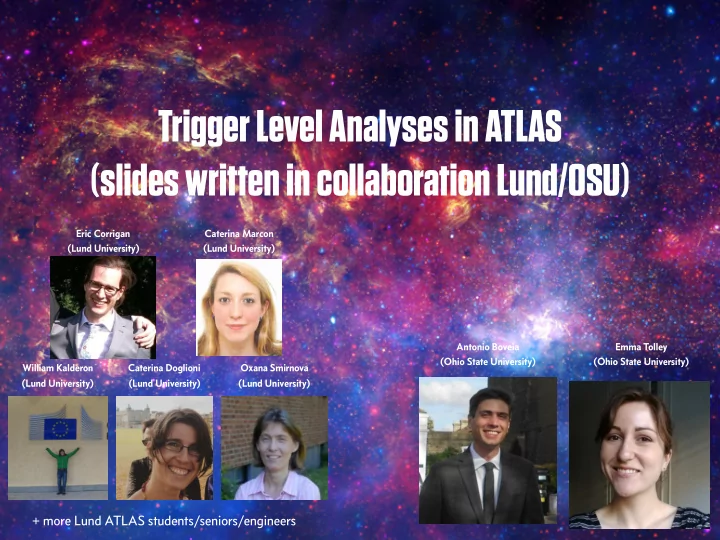

Trigger Level Analyses in ATLAS (slides written in collaboration Lund/OSU) Eric Corrigan Caterina Marcon (Lund University) (Lund University) Antonio Boveia Emma Tolley (Ohio State University) (Ohio State University) William Kalderon Caterina Doglioni Oxana Smirnova (Lund University) (Lund University) (Lund University) + more Lund ATLAS students/seniors/engineers
Trigger systems in ATLAS/CMS ATLAS CMS 40 MHz bunch crossing 40 Level-1: custom hardware Software HLT: 20k cores 1 kHz to storage H. Brun, LP 2015 2
Limitations to recording all data Limited by: fast read-out of o(100M) detector channels computing resources (reconstruction) disk storage (saving for further processing) everyone else’s favourite physics channel Bandwidth = Event rate x Event size LHC: 40 MHz (Reconstructed) ATLAS: 1 kHz ATLAS: o(MB) LHCb: 12.5 kHz LHCb: ~100 kB CMS: 1 kHz CMS: o(MB) Probing for low-rate processes is important: LHC luminosity will increase but energy will not. Readout bandwidth is an important limitation of searches when irreducible backgrounds are large. 3
Dark Matter mediators constraints and DM relic density 5% 68% 27% Ordinary Matter Dark Matter SM SM Dark Energy arXiv:1503.05916 (quark → jet) Med. Mediator mass [GeV] g q g q SM SM (quark → jet) DM SM (invisible) Med. g 𝜓 g q SM DM (invisible) Dark Matter mass [GeV] 4
Dijet Resonances: Constraints on Coupling Values vs. Mass Dobrescu, Yu Phys Rev D 88 035021 ( 2013 ) Coupling of new particle to quarks = 6x g q 5
Dirac WIMP mediators: s- and t-channel vector/axial-vector/scalar/pseudo-scalar MET+heavy flavor, W, Z, and Higgs 6
DM Simplified Model Exclusions ATLAS Preliminary April 2016 DM Mass [TeV] Axial-vector mediator, Dirac DM 1.2 g = 0.25, g = 1 < 0.12 q DM Phys. Rev. D. 91 052007 (2015) 2 h c Dijet 8 TeV Ω 1 = 0.12 2 h Ω c Thermal relic 0.8 s s a M r o t a i d e M Perturbative unitarity = s 2 s 0.6 1 a . M 0 = M 2 D h × Ω 2 c c i l e r Phys. Lett. B 754 302-322 (2016) l a m r e h 0.4 T V e T miss E +jet 13 TeV 3 T 1 miss E + 13 TeV γ 0.2 arXiv:1604.07773 T t e arXiv:1604.01306 j i D 0 0.2 0.4 0.6 0.8 1 1.2 1.4 1.6 1.8 2 2.2 Mediator Mass [TeV] 7
Trigger-Level Analysis technique Record only necessary information for jet search: jets Use information already available to make the decision: HLT jets Reduced size → increase unprescaled trigger rate Event size reduced to 5% of fully recorded event unprescaled prescaled 8
Statistics increase from Trigger-Level Analysis technique Trigger-Level Analysis Standard analysis Number of Number of events events Partially Signal recorded (smaller size) QCD events background Prescaled Fully recorded events events Data Mass of di-jet system Mass of di-jet system (DM mediator mass) (DM mediator mass) 9
Statistics increase from Trigger-Level Analysis technique: dijet invariant mass Statistics increase Performance comparison: trigger/offline response = unity this requires custom offline calibrations for trigger jets 10
Results Dijet + ISR technique 11
ATLAS MET+X and Dijet Searches Benchmark model points: LHC DM WG, arXiv:1703.05703 12
Outlook TLA technique powerful when: - use a subset of the detector information for the search - object already reconstructed in the trigger and close enough to offline Other detectors that could help TLAs: - pile-up subtraction - rely on information computed in trigger and only write out summary information (real- time analysis) g q 0.35 TLA for SMARTHEP PhD project purposes: 0.3 - combine background reduction and TLA: UA2 dijet 0.25 dijet+ISR TLA CDF dijet 0.2 ATLAS ATLAS Benchmark model: dijet+ISR photon high-mass axial vector DM mediator 0.15 ATLAS dijet+ISR dijet photon TLA SM SM SM 0.1 ATLAS Med. dijet+ISR jet ATLAS 0.05 dijet+ISR jet TLA ATLAS dijet TLA g q g q 2000 200 300 1000 Projection of CMS SM SM fat-jet+ISR jet m [GeV] Z' - move towards real-time trigger calibrations for LHC upgrade 13
Additional Slides
Data-driven background fit (UA2 fcn) Trigger Level Analysis: search ATLAS-CONF-2016-030 Jet p T > 185, 85 GeV |y*| = |y 1 -y 2 |/2 < 0.6 (rejects forward-peaking t-channel QCD processes) m jj > 460 GeV |y*| = |y 1 -y 2 |/2 < 0.3 (reaches lower in mass due to forcing more central, higher pT jets) m jj > 396 GeV Most discrepant region (p-value 0.44) Only probing below M ~ 1.2 TeV (high-mass analysis takes over) 15
Jet performance for TLA Performance of trigger jets comparable to that of offline jets Improvements benefit jet trigger as a whole 16
Trigger Level Analysis: results ATLAS-CONF-2016-030 Limits on Gaussian-shape resonances Constraints on DM mediator couplings (for reinterpretation) 17
Introduction Dark Matter and TLA Differently timed analyses Triggering outside the box Data parking / delayed stream Bandwidth = Event rate x Event size Extra bandwidth = Event rate x Event size processed later Run 1 If computing resources for reconstruction limited: park the raw data and wait (delay) until everything else is processed 18 18
Introduction Dark Matter and TLA Differently timed analyses Triggering outside the box ATLAS delayed stream results Number of events Actual recorded Signal arXiv:1407.1376 events from delayed triggers Run 1 Actual events recorded with standard trigger Mass of di-jet system Other analyses using delayed stream in ATLAS/CMS: SUSY search for RPV stops Dijet angular analysis… lphaT Higgs → bbar Fully hadronic top DM searches… 19 19
Recommend
More recommend